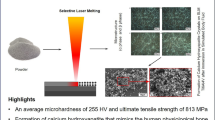Abstract
Background
Adding soluble particulate poragens to antimicrobial-loaded bone cement increases the permeability of the bone cement and increases the antimicrobial release, but the mechanical effect of adding poragens is not well known.
Questions/purposes
We therefore asked the following questions: (1) Does the poragen fraction in antimicrobial-loaded bone cement affect its antimicrobial release? (2) Does poragen fraction in antimicrobial-loaded bone cement affect its compressive strength; and (3) Does the effect on compressive strength change over time in elution?
Methods
Antimicrobial-loaded bone cement made in the proportions of 40 g polymer powder, 20 mL monomer liquid, 1 g tobramycin powder and one of six different doses of poragen powder (0, 1, 2, 4, 8, or 16 g of particulate xylitol per batch) was formed into standardized test cylinders and eluted for 30 days. We determined the cumulative recovered tobramycin and the change in compressive strength over 30 days of elution.
Results
Antimicrobial release progressively increased with increasing poragen fraction. Compressive strength progressively decreased with increasing poragen fraction and with increasing time in elution. Poragen fractions greater than 2 g per batch caused the compressive strength to decrease below 70 MPa over 30 days of elution.
Clinical Relevance
The use of poragens can increase elution of antimicrobials from antimicrobial-loaded bone cement. However, for implant fixation, to avoid deleterious reduction of compressive strength, the amount of poragen that can be added in addition to 1 g of antimicrobial powder may be limited to 2 g per batch.



Similar content being viewed by others
References
American Society for Testing and Materials. Standard Specifications for Acrylic Bone Cement. F451-99. West Conshohocken, PA: American Society for Testing and Materials; 2002.
Belkoff SM, Maroney M, Fenton DC, Mathis JM. An in vitro biomechanical evaluation of bone cements used in percutaneous vertebroplasty. Bone. 1999;25(2 Suppl 1):23S–26S.
Cui Q, Mihalko WM, Shields JS, Ries M, Saleh KJ. Antibiotic-impregnated cement spacers for the treatment of infection associated with total hip or knee arthroplasty. J Bone Joint Surg Am. 2007;89:871–882.
Diefenbeck M, Mückley T, Hofmann GO. Prophylaxis and treatment of implant-related infections by local application of antibiotics. Injury. 2006;37(2 Suppl 1):S95–S104.
Duncan CP, Masri BA. The role of antibiotic-loaded cement in the treatment of an infection after a hip replacement. Instr Course Lect. 1995;44:305–313.
Fernandes PB, Ramer N, Rode RA, Freiberg L. Bioassay for A-56268 (TE-031) and identification of its major metabolite, 14-hydroxy-6-methyl erythromycin. Eur J Clin Microbiol Infect Dis. 1988;7:73–76.
Hanssen AD, Spangehl MJ. Practical applications of antibiotic-loaded bone cement for treatment of infected joint replacements. Clin Orthop Relat Res. 2004;427:79–85.
He Y, Trotignon JP, Loty B, Tcharkhtchi A, Verdu J. Effect of antibiotics on the properties of poly(methylmethacrylate)-based bone cement . J Biomed Mater Res. 2002;63:800–806.
International Organization for Standardization. Implants for Surgery—Acrylic Resin Cements. ISO 5833-2002. Geneva, Switzerland: International Organization for Standardization; 2002.
Jiranek WA, Hanssen AD, Greenwald AS. Antibiotic-loaded bone cement for infection prophylaxis in total joint replacement. J Bone Joint Surg Am. 2006;88:2487–2500.
Kuechle DK, Landon GC, Musher DM, Noble PC. Elution of vancomycin, daptomycin, and amikacin from acrylic bone cement. Clin Orthop Relat Res. 1991;264:302–308.
Lautenschlager EP, Jacobs JJ, Marshall GW, Meyer PR Jr. Mechanical properties of bone cements containing large doses of antibiotic powders. J Biomed Mater Res. 1976;10:929–938.
Lewis G, Bhattaram A. Influence of a pre-blended antibiotic (gentamicin sulfate powder) on various mechanical, thermal, and physical properties of three acrylic bone cements. J Biomater Appl. 2006;20:377–408.
Lewis G, Janna S. Estimation of the optimum loading of an antibiotic powder in an acrylic bone cement. Acta Orthopaedica 2006;77:622–627.
Makinen KK, Bennett CA, Hujoel PP, Isokangas PJ, Isotupa KP, Pape HR Jr, Makinen PL. Xylitol chewing gums and caries rates: a 40-month cohort study. J Dent Res. 1995;74:1904–1913.
McLaren AC, McLaren SG, Hickmon MK. Sucrose, xylitol, and erythritol increase PMMA permeability for depot antibiotics. Clin Orthop Relat Res. 2007;461:60–63.
McLaren AC, McLaren SG, McLemore R, Vernon BL. Particle size of fillers affects permeability of polymethylmethacrylate. Clin Orthop Relat Res. 2007;461:64–67.
McLaren AC, McLaren SG, Smeltzer M. Xylitol and glycine fillers increase permeability of PMMA to enhance elution of daptomycin. Clin Orthop Relat Res. 2006;451:25–28.
McLaren RL, McLaren AC, Vernon B. Generic Tobramycin elutes from bone cement faster than proprietary Tobramycin. Clin Orthop Relat Res. 2008;466:1372–1376
Osterman PA, Seligson D, Henry SL. Local antibiotic therapy for severe open fractures: a review of 1085 consecutive cases. J Bone Joint Surg Br. 1995;77:93–97.
van de Belt H, Neut D, Schenk W, van Horn JR, van der Mei HC, Busscher HJ. Staphylococcus aureus biofilm formation on different gentamicin-loaded polymethylmethacrylate bone cements. Biomaterials. 2001;22:1607–1611.
Acknowledgments
We thank Himanshu Kaul BSE for assistance with this study.
Author information
Authors and Affiliations
Corresponding author
Additional information
All the authors received funding from the Herbert T. Lewis Fund in the Orthopaedic Research and Education Foundation.
This work was performed at Banner Good Samaritan Medical Center, Phoenix AZ and the Center for Interventional Biomaterials, Arizona State University, Tempe AZ.
About this article
Cite this article
Nugent, M., McLaren, A., Vernon, B. et al. Strength of Antimicrobial Bone Cement Decreases with Increased Poragen Fraction. Clin Orthop Relat Res 468, 2101–2106 (2010). https://doi.org/10.1007/s11999-010-1264-1
Published:
Issue Date:
DOI: https://doi.org/10.1007/s11999-010-1264-1




